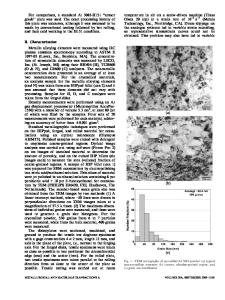Mechanical Properties of a Cryomilled Nanostructured Al-Mg Alloy
- PDF / 1,135,622 Bytes
- 6 Pages / 612 x 792 pts (letter) Page_size
- 80 Downloads / 380 Views
Q1.7.1
Mechanical Properties of a Cryomilled Nanostructured Al-Mg Alloy B.Q. Han a, F.A. Mohamed b, C. Bampton c and E.J. Lavernia a a Department of Chemical Engineering and Materials Science University of California, Davis, CA 95616 b Department of Chemical Engineering and Materials Science University of California, Irvine, CA 92612 c Rocketdyne Division, Boeing, Canoga Park, CA 91309 ABSTRACT The microstructural characteristics and mechanical behavior at room temperature of a nanostructured Al-Mg alloy, with grain sizes of approximately 100 nm, manufactured by a cryomilling process were investigated in the present study. The results reveal an asymmetry of yield strength between tension and compression. On the basis of the mechanical behavior results it appears that the presence of a few micron inclusions may have a negative effect on tensile behavior of the cryomilled nanostructured Al-Mg alloy. INTRODUCTION Interest in the fundamental behavior of nanostructured materials stems from recent reports which suggest that it is possible to manufacture materials with grain sizes in the 10-500 nm range in large quantities [1]. In order to enhance our fundamental understanding of the nature and origin of deformation processes in nanostructured materials, a number of investigations on the tensile mechanical performance of nanostructured materials have been reported [2,3,4]. While strength is consistently observed to increase with decreasing grain size, low ductility is frequently reported in nanostructured materials [5,6]. Occasionally, high ductility has been observed in nanostructured materials, but these appear to be the exception rather than the intrinsic material response [7,8]. This observation has been rationalized on the basis of lowangle boundaries rather than high-angle grain boundaries in nanostructured materials or an experimental artifact of the test procedure and specimen geometry or broad grain size distributions out of the nanocrystalline range [9]. Hence, it is evident that a fundamental understanding of the factors that influence the ductility of nanostructured materials is required if optimal combinations of properties are to be attained. In a related study, the tensile behavior of an ultrafine-grained Al-Mg alloy processed via a cryomilling technique was characterized by high strength, engineering-acceptable ductility and low work hardening, compared to conventional 5083 Al [10]. In addition, a symmetry of tensile and compressive yield strength was observed. The cryomilling technique is promising since it can be used to produce amounts of bulk nanostructured aluminum alloys (grain size
Data Loading...











